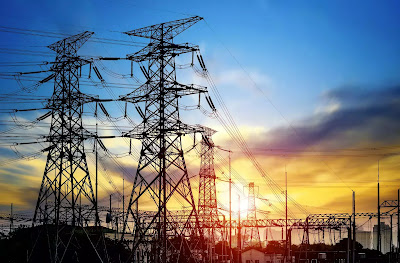Answer the following in brief (2 x 10)
Why Arcing ground should be avoided?
A temporary fault creates an arc between an overhead line and ground. This arc extinguishes and restrikes in repeated and regular manner. This phenomenon is known as arcing ground, which is very common in ungrounded system and should be avoided.What is the function of d.c. reactor?
This is used to improve the input power factor of the inverter power supply and reduce harmonics.Why is plug setting required?
Selection of the required current setting is by means of a plug setting multiplier, which has a single insulated plug. While the plug is withdrawn for adjusting it to a different current setting during on-load condition, the maximum current tap is automatically connected, thus avoiding the risk of open circuiting the secondary of the C.T. under load condition.Explain the concept of speed governor.
This is a fly-ball type of speed governor and constitutes the heart of the system as it senses the change in speed or frequency. With the increase in speed, the fly balls move outwards and the point B on the linkage mechanism moves downwards and vice-versa.How is an impedance diagram drawn?
An Impedance Diagram is a complex quantity having real and imaginary parts; where the real part is the resistance and the imaginary part is the reactance of the circuit.An impedance diagram for the RL circuit is given below.
Why acceleration factor is used in a load flow analysis?
An acceleration factor is a value that can be used to speed up the convergence and reduce the number of required alteration in a Gauss Seidel method of power flow analysis . Very high or very low values may cause the system solution to diverge and slows down convergence. A suitable value for each system can be obtained through trial and error load flow analysis. A generally recommended value of the acceleration factor is 1.6.Why should transmission loss be taken into account in economic dispatch?
The transmission losses may vary from 5 to 15% of the total load, and therefore, it is essential to account for losses while developing an economic load dispatch policy. It is obvious that when losses are present, we can no longer use the simple 'equal incremental cost' criterion.
Why per unit method is widely used in power system calculation?
- Voltages, currents and impedances expressed in per unit do not change when they are referred from one side of the transformer to the other side. This is a great advantage.
- Per unit impedances of electrical equipment of similar type usually lie within a narrow range, when the equipment ratings are used as base values.
Why numerical solution of swing equation is necessary in many cases?
Even in the case of a single machine tied to an infinite bus bar, the critical clearing time cannot be obtained from equal area criterion, and we have to make this calculation in Numerical Solution of the Swing Equation.What is the speed of Turbo-alternator?
High speed alternators are called as Turbo alternators. The range of speed is 1500 to 3000 rpm.
---
The study material for AMIE/Junior Engineer exams is available at https://amiestudycircle.com


Comments